avia.wikisort.org - Aerodrome
Norman Y. Mineta San Jose International Airport[2] (IATA: SJC, ICAO: KSJC, FAA LID: SJC), commonly known simply as San Jose International Airport, is a city-owned public airport in San Jose, California, United States. It is named after San Jose native Norman Mineta, former United States Secretary of Transportation and United States Secretary of Commerce, who also served as Mayor of San Jose and as a San Jose City Councilman.
Norman Y. Mineta San Jose International Airport | |||||||||||||||
|---|---|---|---|---|---|---|---|---|---|---|---|---|---|---|---|
 | |||||||||||||||
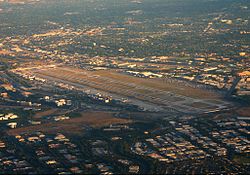 | |||||||||||||||
| |||||||||||||||
| Summary | |||||||||||||||
| Airport type | Public | ||||||||||||||
| Owner/Operator | City of San Jose | ||||||||||||||
| Serves | Bay Area | ||||||||||||||
| Location | San Jose, California, U.S. | ||||||||||||||
| Opened | 1939 | ||||||||||||||
| Focus city for | Alaska Airlines[1] | ||||||||||||||
| Elevation AMSL | 62 ft / 19 m | ||||||||||||||
| Coordinates | 37°21′46″N 121°55′45″W | ||||||||||||||
| Website | www | ||||||||||||||
| Maps | |||||||||||||||
 FAA airport diagram | |||||||||||||||
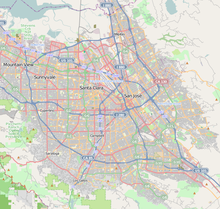 SJC Location in San Jose 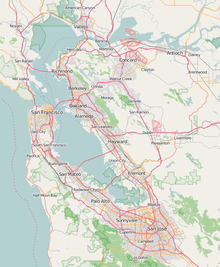 SJC Location in the Bay Area 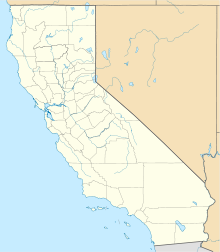 SJC Location in California  SJC Location in the United States | |||||||||||||||
| Runways | |||||||||||||||
| |||||||||||||||
| Statistics (2021) | |||||||||||||||
| |||||||||||||||
While San Jose is the largest city in the Bay Area, SJC is the Bay Area's second-busiest airport by passenger boardings, behind San Francisco International Airport.[5] In addition, the airport is also an official U.S. Customs and Border Protection international port of entry.[6] It is situated three miles northwest of Downtown San Jose[3][7] near the intersections of U.S. Route 101, Interstate 880, and State Route 87. In 2018, 45.4% of departing or arriving passengers at SJC flew on Southwest Airlines; Alaska Airlines was the second most popular airline with about 17.6% of passengers.[8]
Overview

San Jose is the largest city in the Bay Area by both population and area, but SJC is the second-busiest of the three Bay Area airports by passenger count after SFO. SJC served 14.3 million passengers in 2018, surpassing its previous record of 14.2 million passengers set in 2001.[9] SJC has been one of America's fastest-growing major airports for rate of year-over-year seat capacity growth since 2012.[10]
SJC is near downtown San Jose (less than 4 miles (6.4 km) from the city center and easily within city limits), unlike SFO and OAK, which are around 14 miles (23 km) and 10 miles (16 km) from their downtowns. The location near downtown San Jose is convenient, but SJC is surrounded by the city and has little room for expansion. The proximity to downtown limits the height of buildings in downtown San Jose, to comply with FAA rules.[11][12][13][14][15]
History
Beginnings and expansion

In 1939, Ernie Renzel, a wholesale grocer and future mayor of San Jose, led a group that negotiated an option to buy 483 acres (195 ha) of the Stockton Ranch from the Crocker family, to be the site of San Jose's airport. Renzel led the effort to pass a bond measure to pay for the land in 1940. In 1945, test pilot James M. Nissen and two partners leased about 16 acres (6.5 ha) of this land to build a runway, hangar and office building for a flight school. When the city of San Jose decided to develop a municipal airport, Nissen sold his share of the aviation business and became San Jose's first airport manager. Renzel and Nissen were instrumental in the development of San Jose Municipal Airport over the next few decades, culminating with the 1965 opening of what later became Terminal C.[16][17]
San Jose's first airline flights were Southwest Airways Douglas DC-3s on the multistop run between San Francisco and Los Angeles, starting in 1948. Southwest changed its name to Pacific Air Lines and was the only airline at the airport until 1966, when Pacific Southwest Airlines (PSA) started flying Lockheed L-188 Electras nonstop from LAX and Boeing 727-100s later that year. SJC's first airline jets were Pacific Air Lines Boeing 727-100 nonstops to LAX earlier in 1966; Pacific 727s flew nonstop to Las Vegas in 1967.[18] Pacific also flew Fairchild F-27s to SJC, and merged with Bonanza Air Lines and West Coast Airlines to form Air West which was renamed Hughes Airwest, continuing at SJC with McDonnell Douglas DC-9-30s before it merged into Republic Airlines (1979–1986). In 1968 United Airlines arrived, with Boeing 727 nonstops from Denver, Chicago and LAX, and Douglas DC-8 nonstops from New York and Baltimore.
The runway which became 12R/30L was 4,500 feet (1,400 m) until about 1962— Brokaw Rd was the northwest boundary of the airport. In 1964 it was 6,312 feet (1,924 m), in 1965 it was 7,787 feet (2,373 m), and a few years later it reached 8,900 feet (2,700 m), where it stayed until around 1991.[citation needed] The two runways are now both 11,000 feet (3,400 m) in length.[19]
In the early 1980s, the airport was one of the first in the country to participate in the noise regulation program enacted by the U.S. Congress for delineation of airport noise contours and developing a pilot study of residential sound insulation. This program showed that homes near the airport could be retrofitted cost-effectively to reduce indoor aircraft noise substantially.[20]
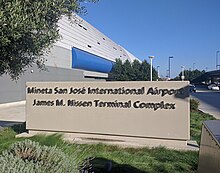
1988–2010: boom and bust
American Airlines opened a hub at San Jose in 1988, using slots it obtained in the buyout of AirCal (formerly Air California) in 1986. In 1990, Terminal A was opened to help accommodate the American operation.[citation needed] The company launched a flight to Tokyo, San Jose's first direct connection to Asia, in March 1991 using DC-10s. The aircraft soon proved ill-suited to the route, however. For instance, the San Jose airport's short runway prevented the planes from taking off with full fuel tanks and passenger loads. Consequently, American replaced the DC-10s with MD-11s.[21][22]
In April 2001, American also commenced the first transatlantic flight from San Jose, a Boeing 767 service to Paris.[23][24] By the summer of that year, the airline served Paris, Taipei, and Tokyo nonstop from San Jose and had domestic flights to Austin, Boston, Denver, Honolulu, Las Vegas, Maui, Orange County, Portland, Phoenix, San Diego and Seattle.[25]

After the September 11 attacks and the dot-com bubble burst in 2001, the city lost much of its service. Air Canada dropped its flights to Toronto and Ottawa, Canada, and American Airlines ended its nonstops to Taipei, Vancouver, and Paris. American also canceled service to Miami, St. Louis, Seattle/Tacoma, Portland (OR), Denver, Orange County, CA and Phoenix; the airline's flights to Los Angeles were downgraded to American Eagle regional flights.
In November 2001, the airport was renamed after Norman Y. Mineta, a native of San Jose, its former mayor and congressman, as well as both a former United States Secretary of Commerce and a United States Secretary of Transportation.[26] That same month, the San Jose City Council approved an amended master plan for the airport that called for a three-phase, nine-year expansion plan.[27] The plan, designed by Gensler and The Steinberg Group, called for a single, consolidated "Central Terminal" with 40 gates (four more than present), an international concourse and expanded security areas. The sail-shaped facade would greet up to 17.6 million passengers a year. A people mover system would link the new terminal with VTA light rail and the planned BART station next to the Santa Clara Caltrain station. Cargo facilities would be moved to the east side of the airport. A long term parking garage would be built where the rental car operations are now. A short term parking lot would be built on the site of Terminal C. On December 16, 2003, the San Jose Airport Commission named the airfield after former mayor Ernie Renzel and named the future Central Terminal after James Nissen.[28] In August 2004, the city broke ground on the North Concourse, the first phase of the master plan.
The originally-approved master plan was scaled-back in 2005.[29][30] The new two-phase plan called for a simplified Terminal B, rather than the initially proposed James Nissen Central Terminal, with a North Concourse to replace the aging Terminal C. In addition, Terminal A would be expanded for additional check-in counters, security checkpoints, and drop-off/pick-up curbside space. The new plan cost $1.3 billion, less than half of the original plan's $3 billion. The first phase was completed on June 30, 2010, when Terminal B and the North Concourse officially opened for service.[31][32] Planning for Phase II began in early 2018, with 6 additional gates to be added along with a new concourse extension at the south end of Terminal B.[33]
Service reductions continued throughout the early 2000s. Alaska Airlines halted its Puerto Vallarta and Cabo San Lucas seasonal routes, Horizon Air ended its Tucson service and American Airlines ended its San Luis Obispo and Boston Logan links. Some additions still occurred. In October 2005, Hawaiian Airlines began daily nonstops to Honolulu.[34][35] In October 2006 American Airlines ended the San Jose–Tokyo–Narita route, San Jose's last nonstop beyond North America and Hawaii.
SJC suffered with many mid-tier airports during the 2008 rise in oil prices as airlines reduced marginal services. The airport lost much of its transcontinental U.S. service in the fall with Continental ending Newark flights, JetBlue ending Boston nonstops, and United ending flights to its Chicago–O'Hare and Washington Dulles hubs.[36] The New York Times reported that between 2007 and 2009, SJC lost 22% of its seat capacity.[37] Frontier Airlines pulled out of SJC in May 2010, citing lack of profitability on its single flight from the airport to Denver, Colorado. In August 2010, Mexicana Airlines also suspended all flights permanently due to bankruptcy.[38]

2010–2019: rebound in service
Beginning in 2010, service expanded at SJC for the first time in several years. Domestic carriers JetBlue Airways and Alaska Airlines added or adjusted service while international carrier Volaris began service in May 2010 with flights to Guadalajara, Mexico. Alaska subsequently expanded offerings to include those in Hawaii and Mexico.[39] The decade saw rapid expansion for the airport- In 2012, Hawaiian Airlines added service to Maui.[40] All Nippon Airways announced it would begin service between San Jose and Tokyo in 2012, restoring the link between the two cities that was lost when American Airlines ended service on the route in 2006. The airline used the Boeing 787 Dreamliner, making San Jose one of the first cities in the United States to see scheduled 787 flights.[41] Due to delivery delays of its 787 aircraft, the airline postponed the launch of the route to early 2013.[42]
In 2015 and 2016, several new international flights were launched. Hainan Airlines began nonstop flights from Beijing.[43] British Airways commenced daily Boeing 787 Dreamliner service from London–Heathrow;[44] Air Canada returned, providing flights from Vancouver operated by Air Canada Express.[45] Later in 2017 and 2018, Volaris expanded its offerings to Mexico with service to Morelia, Leon, and Zacatecas. Not all international routes proved successful. Lufthansa connected SJC and Frankfurt on flights operated by Lufthansa CityLine Airbus A340-300 aircraft,[46] Aeromexico started a daily flight to Guadalajara, and later added seasonal service to Mexico City, and Air China introduced Shanghai–Pudong flights with an Airbus A330-200, but Lufthansa and Air China ended service in 2018 while Aeromexico ceased both flights in January 2019, later resuming Guadalajara for the 2019–2020 winter holiday season.[47][48]
In the wake of its acquisition of Virgin America, Alaska Airlines grew quickly at Mineta Airport as well as San Francisco International Airport between 2015 and 2018, adding intrastate cities like Orange County, Los Angeles, and San Diego, along with east coast destinations Newark and New York-JFK. Alaska has designated SJC a focus city in several articles when announcing new destinations.[49][50] Not all routes were successful, however, as service to Eugene, Burbank, and Dallas-Love ended in 2019, with Santa Ana, New York-JFK, and Tucson ending in 2020.
Other domestic carriers increased service or returned to the airport. Frontier Airlines resumed service to Denver and began flights to Las Vegas.[51] Additional service to Austin, Atlanta, Cincinnati and San Antonio began in the spring of 2018 but did not return the next year.[52] Delta Air Lines added service to its New York–JFK and Detroit hubs.
Southwest Airlines greatly expanded service from 2016 to 2020, connecting almost a dozen new cities across the country to SJC and added flights to Honolulu and Maui in May 2019.[53]
2020–present: COVID-19 pandemic
Beginning in March 2020, the impact of the COVID-19 pandemic on tourism severely curtailed the amount of passenger traffic and flights at the airport. From a high of 15.6 million passengers in 2019, only 4.7 million used the airport in 2020.[54] Frontier Airlines and Hainan Airlines both ended service to SJC, while other airlines suspended or pared back many of their destinations, including all intercontinental service to Asia and Europe.[55] Despite this large downturn in travel and drop in passenger demand,[56] Alaska Airlines added flights to Palm Springs in 2021.[57] Volaris also began a new route to Mexico City in November 2020.[58] By June 2022, travel had recovered sufficiently that British Airways resumed its London-Heathrow service,[59] and Japan Airlines-owned ZIPAIR Tokyo announced new Tokyo-Narita service beginning in December.[60]
Facilities and aircraft
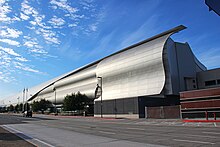
Norman Y. Mineta San Jose International Airport covers 1,050 acres (420 ha) at an elevation of 62 feet (19 m). It has two active runways: 12L/30R and 12R/30L, each 11,000 by 150 feet (3,353 m × 46 m) asphalt/concrete.[note 1][3][61] The runway separation is less than ideal: 700 feet between centerlines.
In the year ending February 28, 2018, the airport had 181,686 aircraft operations, average 498 per day: 66% airline, 13% air taxi, 20% general aviation and <1% military. 133 aircraft were then based at the airport: 46% single-engine, 12% multi-engine, 39% jet and 3% helicopter.[3]
From 1960 to 2010 San Jose State University operated a flight-simulator facility for its aviation program in buildings at the southeast corner of the airport. The university has since moved to the Reid–Hillview Airport about 5 miles southeast.
Terminals


There are two terminals at the airport, Terminal A, opened in 1990 and Terminal B opened in 2010. The terminals are connected airside. In 2009, the gates at the airport were renumbered in preparation for the addition of Terminal B. Gate A16B at the north end became Gate 1 and Gate A1A at the south end became Gate 16.[62] The airport's first modern terminal building, Terminal C, was opened in 1965 and was closed and demolished in 2010. Its location is now a short term parking lot but will be used for the second phase of Terminal B when that facility is constructed.
Terminal A
Terminal A has 17 gates: 1–7, 7A, and 8–16. (Gate 7A is a ground-level gate for remote parking positions.)
Designed by a team of architects and engineers led by HTB, Inc., Terminal A, and its adjoining parking garage was originally designed and built in 1990 for American Airlines. The overall program was led by a joint team of San Jose Airport and Public Works staff known as the "Airport Development Team". The project was awarded the Public Works Project of the Year by the California Council of Civil Engineers. It underwent extensive renovation and expansion in 2009, with larger ground-level ticketing counters, more curbside parking space, larger security checkpoints, and more concessions. The renovations and expansion were designed by Curtis W. Fentress, FAIA, RIBA of Fentress Architects.
The terminal includes an international arrivals building, which contains Gates 15 and 16. All arrivals from international flights at the airport must clear customs and immigration from this building (except for flights from airports with US border preclearance). Gates 17 and 18 in Terminal B were converted to handle international arrivals in early 2015.
The airport's single lounge was an Admirals Club across from Gate 8 for American Airlines passengers operated as part of its hub operation. Along with the drawdown of the airline's hub, it was closed in September 2010, with the airline citing rising costs and the cutbacks in its flight schedule. Terminal A now has two paid-entry lounges called "The Club at SJC" where passengers can wait for their flights and have access to snacks and beverages. Access to "The Club at SJC" is complimentary for passengers who have a Priority Pass card membership. One lounge is near the international gates and the other, opened at the end of 2019, has taken over and renovated part of the former Admirals Club.[63]
Terminal B
![The departure hall of Terminal B, taken in 2011.[lower-alpha 1]](http://upload.wikimedia.org/wikipedia/commons/thumb/b/b2/SJCterminalb.JPG/220px-SJCterminalb.JPG)
Terminal B has 20 gates: 17–36.
The concourse was designed by Gensler and built by Clark Construction, while the Terminal headhouse was designed by Fentress Architects with construction management by Hensel Phelps Construction Co. The terminal officially opened on June 30, 2010. Its design features dramatic daylit spaces, modern art, shared use ticket counters/gates, and chairs with power cords and USB ports on the armrests to charge laptops or handheld devices. The terminal earned a LEED Silver certification from the U.S. Green Building Council in 2010 in recognition of the airport's significant commitment to environmentally sustainable design and construction.[65]
The terminal has two international arrival gates: Gates 17 and 18. All arrivals from international flights at the airport must clear customs and immigration from the International Arrivals building (except for flights from airports with US border preclearance). Gates 17–23 of the new concourse were opened to the public on July 15, 2009. During this time, check-in, security, and baggage claim were all in Terminal A. Gates 24–28 were opened on June 30, 2010, along with Terminal B's pre-security facilities. Southwest Airlines and Alaska Airlines are the primary tenants, along with British Airways.
In 2017, the airport added two gates, Gates 29 and 30, at the south end of the terminal. Due to the airport's growth in recent years, a new temporary facility was added at the south end of the terminal that includes six additional gates as part of the $58 million project. Gates 31-35 opened June 13, 2019, and Gate 36 opened on November 1, 2019.[64]

Former Terminal C
This terminal was built in 1965, before jet bridges (elevated corridors that connect planes to the terminal) became common at airports. Instead of using jet bridges, Terminal C mostly used airstairs. Some airlines, including Alaska Airlines[66] and SkyWest Airlines, used turbo way ramps. In preparation for the construction of Terminal B, the north end of Terminal C was closed for demolition in December 2007. This part of the terminal was home to gates C14–C16, which housed Alaska Airlines, Horizon Air, and Frontier Airlines. The remaining portion of the terminal was reconfigured, including the addition of a new, larger, consolidated security checkpoint. The demolition of the north end occurred in February 2008, clearing the way for construction of Terminal B.[67]
In December 2009, United Airlines, Continental Airlines and JetBlue Airways moved to new or reconstructed gates in Terminal A, as the area within Terminal C containing the three airlines' gates was demolished. Other airlines operating at that time within Terminal C remained there until the North Concourse of Terminal B opened in June 2010. The Terminal C baggage claim was closed for demolition on February 2, 2010. This allowed for the completion of the airport's new roadways. The terminal was officially closed on June 30, 2010.[67] The remaining portions of the terminal were torn down in July 2010 and space the terminal occupied now serves as a surface parking lot.
Airlines and destinations
Passenger
Cargo
| Airlines | Destinations |
|---|---|
| FedEx Express | Memphis |
| UPS Airlines | Louisville |
Statistics


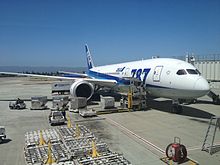
Top destinations
| Rank | City | Passengers | Carriers |
|---|---|---|---|
| 1 | San Diego, California | 478,000 | Alaska, Southwest |
| 2 | Seattle/Tacoma, Washington | 433,000 | Alaska, Delta, Southwest |
| 3 | Los Angeles, California | 411,000 | Alaska, American, Delta, Southwest |
| 4 | Las Vegas, Nevada | 309,000 | Delta, Frontier, Southwest |
| 5 | Phoenix–Sky Harbor, Arizona | 303,000 | American, Frontier, Southwest |
| 6 | Denver, Colorado | 288,000 | Frontier, Southwest, United |
| 7 | Orange County, California | 277,000 | Southwest |
| 8 | Portland, Oregon | 226,000 | Alaska, Southwest |
| 9 | Burbank, California | 217,000 | Southwest |
| 10 | Honolulu, Hawaii | 197,000 | Alaska, Hawaiian, Southwest |
| Rank | City | Passengers | Carriers |
|---|---|---|---|
| 1 | Guadalajara, Mexico | 251,471 | Alaska, Volaris |
| 2 | London–Heathrow, United Kingdom | 115,101 | British Airways |
| 3 | San José del Cabo, Mexico | 107,782 | Alaska, Southwest |
| 4 | Vancouver, Canada | 105,139 | Air Canada |
| 5 | Tokyo–Narita, Japan | 92,518 | ANA |
| 6 | Beijing–Capital, China | 76,497 | Hainan |
| 7 | Morelia, Mexico | 51,899 | Volaris |
| 8 | Guanajuato, Mexico | 26,722 | Volaris |
| 9 | Zacatecas, Mexico | 22,900 | Volaris |
Airline market share
| Rank | Airline | Passengers | Share |
|---|---|---|---|
| 1 | Southwest Airlines | 2,268,000 | 54% |
| 2 | Alaska Airlines | 798,000 | 19% |
| 3 | American Airlines | 378,000 | 9% |
| 4 | Delta Air Lines | 336,000 | 8% |
| 5 | Volaris | 168,000 | 4% |
Annual traffic
| Year | Passengers | Year | Passengers | Year | Passengers |
|---|---|---|---|---|---|
| 1998 | 10,506,173 | 2008 | 9,720,150 | 2018 | 14,319,292 |
| 1999 | 11,452,334 | 2009 | 8,321,750 | 2019 | 15,650,444 |
| 2000 | 13,096,523 | 2010 | 8,246,342 | 2020 | 4,711,577 |
| 2001 | 13,074,467 | 2011 | 8,356,981 | 2021 | 7,357,441 |
| 2002 | 11,117,457 | 2012 | 8,296,392 | 2022 | |
| 2003 | 10,601,190 | 2013 | 8,783,319 | 2023 | |
| 2004 | 11,046,489 | 2014 | 9,385,212 | 2024 | |
| 2005 | 10,891,466 | 2015 | 9,799,527 | 2025 | |
| 2006 | 10,708,068 | 2016 | 10,796,725 | 2026 | |
| 2007 | 10,658,191 | 2017 | 12,480,232 | 2027 |
Accidents and incidents
- September 14–15, 1975 (1130 P – 130 A) – Continental Airlines – Boeing 727 (jet parked overnight). Fred Salomon, a 24-year-old resident of San Jose, had raped a woman, attempted to rob a store, stolen two vehicles, kidnapped a doctor and four others, then attempted to hijack a Continental Airlines Boeing 727 at what was then called San Jose Municipal Airport. The gunman had taken two airline mechanics hostage, demanding that they start the engines on the aircraft. As it started to roll towards the runway, the tires were shot out by police. Standing in the doorway of the jet with a hostage in front of him, while negotiating with police, the gunman pointed his gun at them and was shot and killed by a police sharpshooter, who was positioned on top of the Main Terminal (Terminal C).
- October 25, 1999 – San Jose Police Department McDonnell Douglas 500N helicopter N904PD lost control while entering the traffic pattern at SJC during a maintenance ferry flight. The helicopter crashed into a city street, killing both of the occupants. There were no reported damage or injuries on the ground. The NTSB determined that temporary repairs made in order to ferry the helicopter back to SJC actually made the controllability problem that was intended to be solved worse. Pilot manuals and training for the NOTAR (no tail rotor) helicopter did not provide adequate preparation for the pilot experienced in conventional helicopters to recover from a stuck thruster condition which occurred.
- April 21, 2014 – A teenaged boy scaled a security fence and stowed away in the wheel well of a Hawaiian Airlines Boeing 767, surviving the five-hour flight to Maui. Congressman Eric Swalwell reiterated his call to scrutinize San Jose Airport's security measures. An airport spokeswoman stated that the airport's security "meets and exceeds all federal requirements" and "our thoughts are prayers are with [the stowaway] and his family." She also noted that "no system is 100 percent and it is possible to scale an airport perimeter fence line, especially under cover of darkness and remain undetected and it appears that's what this teenager did."
General aviation
Private and corporate aircraft are based on the west side of the airfield off Coleman Avenue.
- Atlantic Aviation
- AvBase, Inc.
- Signature Flight Support[84]
The former General Aviation services were located on the south end of what is now runway 30R. Plane spotters and photographers now utilize the space where the San Jose State University Aviation Department was formerly located at the corner of Coleman Avenue and Airport Blvd.
Ground transportation
The Santa Clara Valley Transportation Authority (VTA) bus route 60 connects the airport to the Santa Clara Transit Center for Altamont Corridor Express, Caltrain, and Capitol Corridor rail services, as well as numerous VTA bus routes; to the Metro/Airport Light Rail Station for VTA's light rail service; and to the Milpitas station for BART rail services.[85]
The airport is served by various taxi and vehicle for hire companies, and is accessible from highways Interstate 880, and US Route 101 via California State Route 87.[86] There are five parking lots, including Economy Lot 1, Hourly Lots 2, 3, and 5 and Daily Lot 4. Rental car operations are located at the multi-story CONRAC garage across from Terminal B.[87] A free cellphone waiting area exists across State Route 87 from the airport.[88] Inter-terminal and Economy parking lot busing is provided by the airport at no charge.
See also
- List of attractions in Silicon Valley
- List of airports in California
- List of Class C airports in the United States
- Reid–Hillview Airport, general aviation reliever airport also in San Jose, 4 miles ESE of SJC
Notes
- Line 16 of Terminal B: In 2017, the airport added two gates, Gates 29 and 30, at the south end of the terminal. Due to the airport's growth in recent years, a new temporary facility was added at the south end of the terminal that includes six additional gates as part of the $58 million project. Gates 31-35 opened June 13, 2019, and Gate 36 opened on November 1, 2019.[64]
References
- "Network – Alaska Airlines". Newsroom – Alaska Airlines. Alaska Airlines. August 2018. Archived from the original on November 4, 2018. Retrieved November 3, 2018.
Though Alaska calls Seattle home, the company has hubs in Anchorage, Alaska, Los Angeles, San Francisco and Portland, Oregon. Other focus cities include San Diego and San Jose, California.
- "Airport Activity". Mineta San Jose International Airport. January 2019. Archived from the original on March 28, 2019. Retrieved March 27, 2019.
- FAA Airport Form 5010 for SJC PDF, effective December 30, 2021
- FAA Passenger Boarding Data Archived September 12, 2009, at the Wayback Machine for 2006, as published November 26, 2007.
- "Mineta San Jose Airport surpasses Oakland for number of travelers". KGO-TV (ABC7 News). December 19, 2018. Archived from the original on August 25, 2019. Retrieved June 14, 2019.
- "Port of Entry – San Jose International Airport". Cbp.gov. September 28, 2005. Archived from the original on October 30, 2012. Retrieved April 29, 2013.
- "San Jose International Airport". Geographic Names Information System. United States Geological Survey, United States Department of the Interior. Retrieved May 3, 2009.
- "Norman Y. Mineta San Jose International Airport Comprehensive Annual Financial Report Fiscal Years Ended June 30, 2018 and 2017" (PDF). Norman Y. Mineta San Jose International Airport. June 30, 2018. Retrieved November 11, 2019.
- https://www.bizjournals.com/sanjose/news/2019/03/11/southwest-alaska-sjc-san-jose-airport-growth.html [bare URL]
- "Archived copy" (PDF). Archived (PDF) from the original on December 6, 2018. Retrieved December 6, 2018.
{{cite web}}: CS1 maint: archived copy as title (link) - Hamm, Andrew (February 24, 2006). "San Jose studying building heights vs. airport flights issue". San Jose Business Journal. Archived from the original on March 5, 2008. Retrieved July 10, 2008.
- "Zoning Ordinance: Downtown Height Study". City of San Jose. January 29, 2007. Retrieved July 10, 2008. [dead link]
- Lohse, Deborah (January 30, 2007). "San Jose skyline vs. flight path". San Jose Mercury News. Archived from the original on September 10, 2012. Retrieved July 10, 2008.
- Code of Federal Regulations, Title 14 § 77.1 et seq.. Safe, efficient use, and preservation of the navigable airspace.
- Downtown Airspace and Development Capacity Study Progress Report Archived January 16, 2019, at the Wayback Machine (September 2018)
- Proposed Norman Y. Mineta San Jose International Airport Public Art Master Plan Archived January 30, 2005, at the Wayback Machine, Rome Group and City of San Jose Office of Cultural Affairs, November 16, 2004.
- Airport Report Archived February 8, 2004, at the Wayback Machine, Norman Y. Mineta San Jose International Airport, 2(8), January 2004
- www.pacificairlinesportfolio.com. "Pacific Air Lines Portfolio". www.pacificairlinesportfolio.com. Archived from the original on April 1, 2019. Retrieved October 30, 2019.
- "(KSJC) Norman Y Mineta San Jose International Airport". Retrieved September 13, 2021.
{{cite web}}: CS1 maint: url-status (link) Airline Owners and Pilots Association - C. Michael Hogan and Ballard George, Design of Acoustical Insulation for Existing Residences in the Vicinity of San Jose Municipal Airport, Issues in Transportation-Related Environmental Quality, Transportation Research Board, National Research Council, Transportation Research Record 1033, Washington, D.C. (1985)
- Pelline, Jeff (April 5, 1991). "Non-stop flights are non-non-stop". Fort Worth Star-Telegram. pp. 1, 2.
- Barinaga, Marcia (July 19, 1991). "Temperature, runway length set plane's maximum weight". San Jose Mercury News. Retrieved August 6, 2022.
- "Fly direct to Taipei, Paris from San Jose". The San Francisco Examiner. April 1, 2001. Retrieved August 7, 2022.
- "American Airlines launches service to Paris and Taipei". Silicon Valley/San Jose Business Journal. April 20, 2001. Retrieved August 7, 2022.
- "AA timetable, 07/02/2001". Archived from the original on October 31, 2013. Retrieved August 29, 2013.
- Airport Report Archived September 28, 2007, at the Wayback Machine, Norman Y. Mineta San Jose International Airport, 4(3), August 2005
- Tonseth, Ralph G. (January 20, 2004). "Central Terminal and North Concourse Concept Design" (PDF). City of San Jose. p. 1. Archived (PDF) from the original on March 4, 2016. Retrieved August 16, 2015.
- "San Jose City Council & General Plan Amended Agenda, December 16, 2003". City of San Jose. December 16, 2003. Archived from the original on March 4, 2016. Retrieved August 16, 2015.
- Lohse, Deborah; Foo, Rodney (November 11, 2005). "Airport Plan 'Cheaper, Faster'". San Jose Mercury News.
- Foo, Rodney (November 16, 2005). "City Council Approves New, Slimmed-Down Airport Plan". San Jose Mercury News.
- Rodriguez, Joe (June 22, 2010). "San Jose Airport Swoops into the Future". San Jose Mercury News. Archived from the original on October 1, 2012. Retrieved July 2, 2010.
- Fernandez, Lisa (June 30, 2010). "San Jose airport: First-day passengers give Terminal B rave reviews". San Jose Mercury News. Archived from the original on March 3, 2016. Retrieved August 16, 2015.
- "An expansion on the horizon for San Jose International Airport". KTVU News. January 25, 2018. Archived from the original on January 26, 2018. Retrieved January 26, 2018.
- "Hawaiian Airlines to start daily San Jose service". May 17, 2005. Archived from the original on October 25, 2012. Retrieved June 23, 2010.
- "Hawaiian Airlines to Launch Daily Nonstop Service Between San Jose/Silicon Valley and Honolulu Starting October 1". Archived from the original on June 13, 2010. Retrieved June 23, 2010.
- Molina, Joshua (August 20, 2008). "San Jose airport losing three East Coast flights". San Jose Mercury News. Archived from the original on September 14, 2012. Retrieved August 20, 2008.
- Goel, Vindu (October 24, 2009). "San Jose Improves Its Airport; Now, Just Flights Lag". New York Times. Archived from the original on December 29, 2016. Retrieved July 2, 2010.
- "Grupo Mexicana Informa – Press Releases". Mexicanainforma.com. Archived from the original on January 29, 2013. Retrieved April 29, 2013.
- "Airliners Gallery World Airline News". Seattle Post-Intelligencer. July 29, 2010. Archived from the original on July 1, 2012. Retrieved July 29, 2010.
- "Hawaiian Launching San José – Maui Service in January" (Press release). September 6, 2011. Archived from the original on January 17, 2018. Retrieved January 16, 2018.
- Gomez, Mark (December 21, 2011). "All Nippon to serve San Jose with new Boeing 787". San Jose Mercury News. Archived from the original on January 12, 2012. Retrieved December 21, 2011.
- "San Jose–Tokyo flight, awaiting new 787s to roll off Boeing assembly line, won't take off until early 2013 – San Jose Mercury News". Mercurynews.com. April 29, 2013. Archived from the original on February 22, 2014. Retrieved April 29, 2013.
- "Hainan Airlines launches fourth US destination". Anna.aero. June 16, 2015. Archived from the original on January 7, 2016. Retrieved May 7, 2016.
- Baskas, Harriet (May 7, 2016). "British Airways starts San Jose–London Dreamliner service". USA Today. Archived from the original on May 8, 2016. Retrieved May 7, 2016.
- Giwargis, Ramona (November 19, 2015). "Air Canada is coming back to the San Jose airport". San Jose Mercury News. Archived from the original on May 21, 2016. Retrieved May 7, 2016.
- "Lufthansa Delays San Jose CA Launch to July 2016". Airline Route. February 8, 2016. Archived from the original on February 11, 2016. Retrieved May 7, 2016.
- "Air China's Latest U.S. Expansion Connects Silicon Valley and Shanghai" (Press release). San Jose, CA. Business Wire. June 9, 2016. Archived from the original on June 14, 2016. Retrieved June 9, 2016.
- "Air China cuts flights between San Jose and Shanghai". July 17, 2018. Archived from the original on July 18, 2018. Retrieved July 18, 2018.
- "Alaska Airlines to Add New Portland-Austin and Eugene-San Jose Flying This Fall" (Press release). June 1, 2015. Archived from the original on January 17, 2018. Retrieved January 16, 2018.
- "Alaska Airlines Grows San Jose Focus City with New Flying to San Diego and Orange County/Santa Ana" (Press release). February 17, 2016. Archived from the original on November 7, 2017. Retrieved January 16, 2018.
- Frontier Airlines adds San Jose airport service at $29 intro fare, July 18, 2017, archived from the original on January 17, 2018, retrieved January 16, 2018
- Frontier Airlines adds nonstop San Jose flights amid expansion push, San Jose Mercury, September 19, 2017, archived from the original on January 17, 2018, retrieved January 16, 2018
- "Hawaii, here we come!". Southwest Airlines Newsroom. Archived from the original on April 30, 2019. Retrieved October 29, 2019.
- "San Jose airport grapples with fewer passengers". May 3, 2021. Retrieved November 21, 2021.
- "Airlines shrug at costs from San Jose building policy". November 2, 2021. Retrieved November 21, 2021.
- "San Jose airport grapples with fewer passengers". May 3, 2021. Retrieved June 11, 2021.
- "Alaska Airlines Announces New Service from Mineta San José International Airport to Washington, Oregon and Montana" (PDF).
- "Volaris Announces New Nonstop Service to Mexico City from Mineta San José International Airport" (PDF).
- "London-San Jose direct flights soar with British Airways relaunch". June 14, 2022. Retrieved June 15, 2022.
- "Low-cost Japan-based airline will launch Tokyo-San Jose flights". June 15, 2022. Retrieved June 15, 2022.
- "SJC airport data at skyvector.com". skyvector.com. Retrieved August 27, 2022.
- "Airport Construction Update". Mineta San Jose International Airport. July 28, 2009. Archived from the original on June 13, 2010. Retrieved July 2, 2010.
- "Mineta San Jose International/Silicon Valley Airport – Traveler Information – The Club at SJC – Amenities". Archived from the original on June 5, 2015. Retrieved June 4, 2015.
- "San Jose International Airport celebrates opening of additional boarding gates". June 14, 2019. Archived from the original on June 15, 2019. Retrieved June 14, 2019.
- "Silicon Valley's Airport Earns LEED® Silver for New Terminal B Concourse". www.sjc.org. Archived from the original on March 4, 2012.
- "Service improvement benefits Alaska passengers". Airport Report. Norman Y. Mineta San Jose International Airport. 3 (1). June 2004. Archived from the original on February 12, 2008.
- "Norman Y. Mineta San Jose International Airport". airports-worldwide.com. Archived from the original on May 5, 2018. Retrieved May 4, 2018.
- "Flight Timetable". Archived from the original on February 2, 2017. Retrieved April 7, 2018.
- "American Airlines resumes Charlotte-San Jose CA service in Oct 2022". AeroRoutes. June 22, 2022. Retrieved June 22, 2022.
- "Flight schedules and notifications". Archived from the original on February 2, 2017. Retrieved December 5, 2018.
- Pearson, James (January 10, 2022). "Gone Again: British Airways Pulls 3 US Routes For The Rest Of Winter". Simple Flying.
- "FLIGHT SCHEDULES". Archived from the original on June 21, 2015. Retrieved December 5, 2018.
- "Destinations". Archived from the original on January 29, 2018. Retrieved April 7, 2018.
- "JetBlue Airlines Timetable". Archived from the original on July 13, 2013. Retrieved April 7, 2018.
- "Southwest Airlines Extends Flight Schedule Through Jan. 4, 2023". Retrieved June 16, 2022.
{{cite web}}: CS1 maint: url-status (link) - "Check Flight Schedules". Archived from the original on February 2, 2017. Retrieved April 7, 2018.
- "Timetable". Archived from the original on January 28, 2017. Retrieved April 7, 2018.
- "Volaris Flight Schedule". Archived from the original on February 27, 2017. Retrieved April 7, 2018.
- "ZIPAIR TOKYO SCHEDULES MID-DEC 2022 TOKYO – SAN JOSE LAUNCH". Aeroroutes. September 16, 2022. Retrieved September 17, 2022.
- "RITA | BTS | Transtats". Transtats.bts.gov. Retrieved October 23, 2022.
- "International_Report_Passengers | Department of Transportation – Data Portal". data.transportation.gov. Retrieved July 26, 2021.
- "2021 Facts & Figures". Mineta San José International Airport. Retrieved September 5, 2021.
- "California Air Traffic Statistical Reports". Archived from the original on December 1, 2017. Retrieved November 21, 2017.
- "SJC/KSJC Norman Y. Mineta San Jose International Airport". Signature SJC. Archived from the original on April 22, 2016. Retrieved April 14, 2016.
- "Route 60 replaces Route 10 service 12/28, rerouted to airport & Milpitas". VTA. Archived from the original on December 28, 2019. Retrieved December 28, 2019.
- "Directions". San Jose International Airport. Archived from the original on January 22, 2018. Retrieved January 21, 2018.
- "Rental Cars". San Jose International Airport. Archived from the original on January 22, 2018. Retrieved January 21, 2018.
- "Parking". San Jose International Airport. Archived from the original on January 22, 2018. Retrieved January 21, 2018.
- As of 2014, former runway 11/29 (4,599 by 100 feet (1,402 m × 30 m)) is closed indefinitely and is now a taxiway.
External links
- Official website
- FAA Airport Diagram (PDF), effective November 3, 2022
- Resources for this airport:
- AirNav airport information for KSJC
- ASN accident history for SJC
- FlightAware airport information and live flight tracker
- NOAA/NWS weather observations: current, past three days
- SkyVector aeronautical chart for KSJC
- FAA current SJC delay information
На других языках
[de] Flughafen San José
Der Flughafen San José (englisch Norman Y. Mineta San José International Airport) ist der Verkehrsflughafen der Stadt San José im US-Bundesstaat Kalifornien und der kleinste der drei internationalen Flughäfen in der San Francisco Bay Area nach dem San Francisco International Airport und dem Flughafen Oakland.- [en] San Jose International Airport
[es] Aeropuerto Internacional de San José
El Aeropuerto Internacional de San José Norman Y. Mineta (IATA: SJC, OACI: KSJC, FAA LID: SJC) es un aeropuerto de propiedad pública de la ciudad de San José[4] en el condado de Santa Clara, California, Estados Unidos. El aeropuerto está localizado a dos millas náuticas (4 km) al noroeste del centro de San José, cerca de la intersección de tres autopistas importantes, Ruta Estatal 101, Interestatal 880, y la Ruta Estatal 87. La aerolínea dominante es Southwest Airlines y Alaska Airlines es la segunda más importante. El aeropuerto cuenta con Wifi gratis en todas las terminales.[fr] Aéroport international de San José
@media all and (max-width:720px){body.skin-minerva .mw-parser-output *[class*="infobox"] table{display:table}body.skin-minerva .mw-parser-output *[class*="infobox"] caption{display:table-caption}}[it] Aeroporto Internazionale di San Jose-Norman Y. Mineta
L'aeroporto internazionale di San Jose è un aeroporto situato a 4 km a nord ovest dal centro di San Jose, negli Stati Uniti d'America.Другой контент может иметь иную лицензию. Перед использованием материалов сайта WikiSort.org внимательно изучите правила лицензирования конкретных элементов наполнения сайта.
WikiSort.org - проект по пересортировке и дополнению контента Википедии